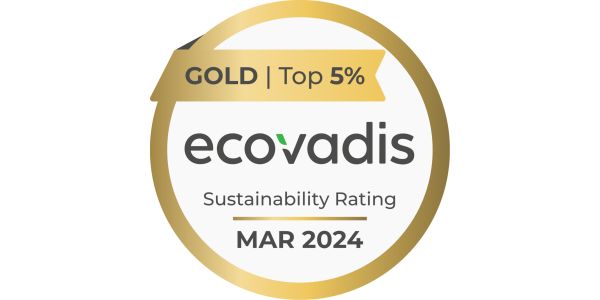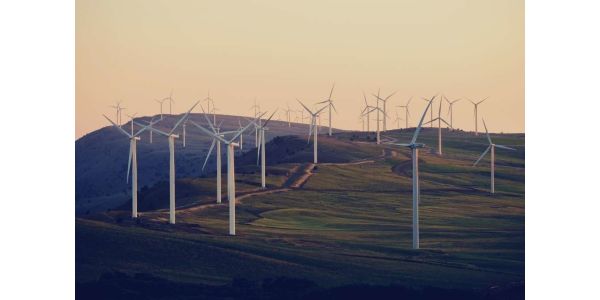Creating access to a sustainable future
Sustainability Framework 2021-2027
We demonstrate leadership in many areas of sustainability and drive a sustainable development in the access solutions market.
We are aware of the most urgent global challenges, as well our customers’ increasing demand for more sustainable products for every place that matters. To respond to the needs and expectations of our society and customers, we put sustainability at the core of our vision, which underlines our long-term commitment to shaping a more sustainable industry and future.
As part of our new strategy, we reassessed our material topics. By monitoring global trends and engaging with our key stakeholders in constructive dialogues, we were able to identify 10 topics, which are the most relevant for our stakeholders and for those where we have the highest impact on sustainable development. Our new sustainability framework is in line with our most material issues, which are aligned to three Pillars: People, Planet and Partnerships.
Click through the interactive visual below to learn more!
Sustainability Targets
Our targets for a more sustainable future
We have set clear sustainability targets within all three Pillars. We will focus our efforts on achieving these targets to do what we say and live up to our commitment to contribute to sustainable development.
Material Topics | Target | Target year | Baseline FY 20/21 |
|---|---|---|---|
Fair Employment | Maintain our employee engagement score at or above the IBM Global Norm | 2027 | 70* |
Training & Education | Increase average training hours to 20 hours per employee | 2027 | 13 hours / FTE |
Diversity & Inclusion | 1 in 3 managers are women | 2027 | 19% |
25% women in succession planning for senior management positions | 2027 | 14% | |
Occupational Health & Safety | Decrease the recordable work-related injury rate by 33% | 2027 | 1.4 |
*Baseline FY 2019/20 in line with the latest dormakaba dialogue results
Learn about the progress we made on each target in our latest Sustainability Report.
Material Topics
Energy & Emissions
Target | Target year | Baseline FY 20/21 |
|---|---|---|
Reduce operational emissions 42% in line with a 1.5°C future | 2030 | 74,770 tCO2e* |
Reduce value chain emissions from purchased goods & services, and the use of sold products by 25% | 2030 | 1,124,936 tCO2e* |
Become carbon neutral in our operations | 2030 | - |
Achieve net-zero emissions | latest 2050 | - |
Have best in class energy efficiency for new products | 2023 | - |
Reduce energy intensity of our operations by 25% | 2030 | 100.5 MWh/mCHF* |
80% of purchased electricity is from green sources | 2030 | 45.5% |
100% of fleet in Germany, France and the UK is electric or hydrogen-based | 2030 | - |
All manufacturing sites maintain energy management systems based on ISO 50001 | 2023 | 21%** |
Circular Economy & Materials
Target | Target year | Baseline FY 20/21 |
|---|---|---|
All new product developments and optimizations are covered by our circularity approach | 2023 | - |
We offer extended producer responsibility take-back schemes for all products and packaging in ten top sales countries | 2027 | - |
Zero fossil-fuel based plastic used in packaging | 2027 | 1,088 tons |
100% of paper, wood and carton stems from responsible forestry sources as accepted by the US Green Building Council | 2027 | - |
Double the total number of sustainability-related product declarations/certifications, including Cradle to Cradle and for recycled content | 2027 | 170 |
Zero waste to landfill in operations | 2027 | 3,443 tons |
*Baseline FY 19/20 in line with Science Based Targets initiative validation
**Baseline FY 2019/20
Learn about the progress we made on each target in our latest Sustainability Report.
Material Topics
Supplier Sustainable Development
Target | Target year | Baseline FY 20/21 |
|---|---|---|
Assess all high-risk suppliers for their sustainability management by a third-party or off-board them for lack of participation | 2027 | 10% |
At least 45% of our high-risk suppliers participate in our sustainability engagement program | 2027 | 10% |
Close at least 80% of high priority corrective actions in case of assessed suppliers | 2027 | - |
90% of assessed suppliers with priority findings have completed a sustainability training | 2027 | - |
Provide information regarding conflict minerals for high-risk suppliers | 2027 | - |
Human Rights
Target | Target year | Baseline FY 20/21 |
|---|---|---|
Reduce risk of forced labor for migrant workers by providing ethical recruitment trainings for all our labor agents in sending and receiving countries | 2027 | - |
Support the right to water in communities where we manufacture by establishing water stewardship programs in areas of high water scarcity, with no absolute increase in water consumption and reducing water intensity by 28% | 2027 | 75,086 m3 absolute consumption and 25.5 L/hours worked* |
Ensure supply chain traceability for minerals having high risk of child labor | 2027 | - |
Customer Health & Safety
Target | Target year | Baseline FY 20/21 |
|---|---|---|
Collaborate on health & safety training with subcontractors & installation partners | 2027 | - |
Collaborate on training and provide information materials on safe operation of our products to all end-users | 2027 | - |
At least 1 corrective action and/or 1 awareness training for each product-related injury | 2027 | - |
*Baseline FY 19/20
Learn about the progress we made on each target in our latest Sustainability Report.
Decade of Action
Our contribution to the UN Sustainable Development Goals (SDGs)
The United Nations has called this the Decade of Action, drawing attention to the need to mobilize governments, businesses and all people to make the Global Goals a reality by 2030. We have joined the call and do our part by contributing to 9 of the Sustainable Development Goals (SDGs).
Global Goal 3: Ensure healthy lives and promote well-being for all at all ages
How we are contributing
We provide our customers with transparent product declarations on the materials used, under the Health Product Declaration (HPD) standard, as well as in accordance with related regulations such as REACH and RoHS. Several products have qualified as testing for low emissions of volatile organic compounds. We continuously work to reduce the use of hazardous materials in our production processes, and our filter systems to ensure that potentially hazardous substances are not released externally.
Global Goal 4: Ensure inclusive and equitable quality education and promote lifelong learning opportunities for all
How we are contributing
We offer various training and development programs for our employees, and also partner with local schools and universities by offering apprenticeships and internships as well as work-study programs. To raise awareness about sustainable development, we regularly communicate our sustainability initiatives to the employees, and offer eLearning modules on the topic. Furthermore, by 2027 we aim to increase average training hours to 20 hours per employee per year (baseline 13 hours/FTE in FY 2020/21).
Global Goal 5: Achieve gender equality and empower all women and girls
How we are contributing
We recognize, respect and embrace the differences between each other and provide fair opportunities for our employees. By 2027 we want to achieve our target that one-third of our managers are female, additionally to improve the gender diversity of our leadership pipeline. As signatories of the UN Women's Empowerment Principles (WEPs), we are committed to implementing the seven principles that guide businesses to foster gender equality and women’s empowerment.
Global Goal 7: Ensure access to affordable, reliable, sustainable and modern energy for all
How we are contributing
Almost 30% of our total energy consumption comes from renewable sources. Key decarbonization projects and initiatives which began in the financial year 2024/25 will result in total emissions avoidance of approximately 1,700 tCO₂e. These include photovoltaic solar installation, upgrading equipment such as air compressors, and chillers, and improving fuel efficiency. Our approach aligns with our commitment to the Science Based Targets initiative (SBTi) and the Paris Agreement.
Global Goal 8: Promote sustained, inclusive, and sustainable economic growth, full and productive employment and decent work for all
How we are contributing
We are committed to providing our nearly 16,000 employees with fair working conditions, including healthy working environments, fair compensation, and full respect for the ILO core labor standards. Our Group-wide Responsible Labor Directive regulates the minimum business standards applied during recruiting, hiring, and employment regarding freely chosen employment, working hours, wages and benefits, the prevention of child labor, freedom of association, and workers' accommodation. Besides this, the Zero Recruitment Fees Directive regulates the business standards regarding fees and costs associated with recruitment governed by the Employer Pays Principle. Furthermore, thinking about our supply chain, these principles are also enshrined in our Supplier Code of Conduct, in our Sustainable Procurement Directive, and are part of our supplier risk assessments.
Global Goal 9: Build resilient infrastructure, promote inclusive and sustainable industrialization, and foster innovation
How we are contributing
Our Group-wide Directive Environment regulates minimal business standards in manufacturing practices, and product circularity and eco-design, including material selection, and energy efficiency of the product use phase. The dormakaba sustainability commitment and life cycle approach are also integrated into our Product Design Manual. Furthermore, our circularity approach is now integrated in our new product development process through the mandatory EcoDesign Specification Template. This includes guidelines on energy use, materials selection, longevity/durability, repairability, adaptability and disassembly. The template also defines minimum values for the amount of recycled content for each product class and how to design and select the product packaging.
We have several examples in place to provide transparent information on our products, including material compliance activities, and publishing product declarations and sustainability-related certifications. Furthermore, our digital Product CO2 Inventory Tool provides information on the carbon emissions of energy-consuming products during their use phase.
We also offer products that help our customers achieve their own sustainability goals. Our sensor-controlled automatic door system, MotionIQ significantly contributes to improving the energy balance of the building, reducing operating costs, and ensuring greater safety during operation. Furthermore, our consulting tool, the Door Efficiency Calculator, helps customers find the most suitable automatic doors in terms of the energy balance of the building, costs, and carbon footprint.
Global Goal 10: Reduce inequalities within and among countries
How we are contributing
We are committed to “Zero Recruitment Fees” throughout our global operations. We take special care to enforce the Employer Pays Principle, particularly in the recruitment of foreign workers to facilitate orderly, safe, and responsible migration and mobility of people. Should we discover that recruitment fees have been paid by our employees, we are committed to reimburse these in a short time frame.
Furthermore, in the financial year 2024/25, we carried out our first global living wage gap assessment across all our locations to verify whether even our lowest-paid workers are compensated enough to afford the necessities of life based on the local cost of living. We are committed to conducting annual living wage gap assessments and developing actions to close any gaps that might exist.
Global Goal 12: Ensure sustainable consumption and production patterns
How we are contributing
The generation of different waste streams is an inevitable consequence of our operations, although by implementing the circular economy approach, we aim to send zero waste to landfill in our operations by 2027 (baseline 3,443 tons in the financial year 2020/21). To achieve this, 33 manufacturing sites have been tasked with developing road maps and received training and guidance from external experts. We monitor our waste by treatment method and waste type. As a result, we have cut landfill waste by more than half since the baseline year. Approximately 88% of the waste stream was diverted away from disposal and instead recycled, reused, or recovered in the financial year 2024/25.
Global Goal 13: Take urgent action to combat climate change and its impacts
How we are contributing
We have committed to science-based carbon emission targets to support limiting global temperature rise to 1.5°C. Our goal is to achieve carbon neutrality in our operations by 2030 and reach net-zero emissions by 2050. To realize a 42% reduction in our Scope 1 and 2 emissions, we have identified six key levers with essential initiatives that must be implemented by 2030. The initiatives are being carried out at dormakaba sites, where we can make the most significant impact in reducing our CO₂ emissions. These form the foundation of our climate transition plan.
Sustainability Insights
Contact
For any inquiries regarding sustainability at dormakaba, please contact us.











